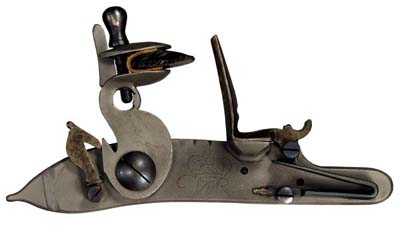Doglocks
The English Lock, which appeared c. 1630,
used a mechanism with characteristics of both older Snaphaunce and the True
Flintlock, which was already being developed in France and Holland.
The English Lock frizzen and pan cover were combined in a single L-shaped
unit but various sear mechanisms which were tried proved to be unreliable.
The older Snaphaunce could be rendered “safe” by swinging the frizzen away
from the pan whose priming was contained by a separate, sliding pan cover.
The English Lock had an integral frizzen and pan cover which was prone to
accidental discharge if the sear became worn or faulty. To offset this
mechanical deficiency the external catch or “Dog” was attached to the
lockplate, close to the cock, in such a way that it could secure the cock,
most positive, when set at “half-cock”.
Towards the end of the 17th century the True Flintlock superseded the
English Lock and the improved sear obviated the need for the dog
nevertheless for another 20 to 30 years this extra safety feature was
retained, until about 1720, especially on military muskets.
When the much refined “Brown Bess” was officially adopted as the English
Governments “regulation arm” c.1720, thousands of these older doglock guns
still existed in serviceable condition. Some were used by the English
Navy-notoriously parsimonious in matters of its supplies - great numbers
were shipped to North American Colonies for military, general purposes, and
trade use. Undoubtedly their rugged construction ensured their survival well
into the second half of the 18th Century.
These muskets, predating the “Brown Bess”, were plain sturdy guns with
simple, almost crude, features: Locks were large, unbridled, and flat faced,
held to the stock with three screws, incorporating heavy spring and
reinforced, ring-necked cocks and the pivoting dog catch. They were normally
fully stocked (sometimes cut back a little at the muzzle) of ash, walnut, or
other hardwood. There is no carving on the thick wrists and butts. Barrels
might be either full round or octagon round (called squared), of varying
lengths up to 46" in .75 caliber. The tang screw was fitted from below.
Furniture was very plain brass or iron. Flat butt plate simply nailed on.
The flat side plate was typically of “serpent” form. Trigger Guards were
either sheet metal or cast, with single nail or screw at the rear with
barrel tang screw head supporting the front finial. Ramrod pipes were folded
sheet metal with no entry pipe.
These distinctive features are truly represented in the models offered.
References: “Weapons of the American Revolution” (G. Neumann)
“North-West Gun” (Hanson)
“British Military Firearms” (Blackmore)
We have nice stock patterns available for the doglocks we offer. We also
have a left hand Doglock (735) available now. The (844) is a little more
beefy than the others. The Cookson (553) and (735) is more of a
semi-graceful early hunting gun even though at one time the locks were
Military Pattern. Many of these doglock muskets were bought by the Hudson
Bay Company and traded to the Indians. Many of their features carried on in
the later trade fusils.

